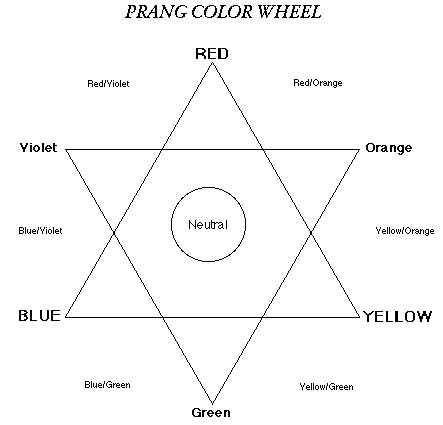The Color Computer
 |
Color theory and diagrammatic representation assumes pigments to be equal in chroma strength. In the real world pigments & dye colors vary in chroma intensity.
You might use unequal measures of 2 pigments to reach a true 50-50 mix of color intensity.
USING The COLOR COMPUTER
( following are instructions for use of the Color Computer)
Every furniture finisher should study the Prang color wheel as represented by the Color Computer. It is essential that one understands the color spectrum first. Once this is accomplished it is very simple to understand the Color Computer and put it to use.
Refer to the Theory of Color and the above diagram of the Prang color spectrum.
Before we start working with the color computer, let us examine it closely. With the computer before you, face up. The 5 colors on the inner disc are the 3 primary colors of red, blue, and yellow, plus black and white. The colors on the outer rim are the 12 colors of the Prang color spectrum. By revolving the inner disc and aligning the 3 primaries, plus black and white with each of the 12 colors of the Prang color spectrum on the outer rim, you can see a 50/50 mix of 60 different combinations.
Position the Color Computer so that red on the outer rim is at the top (12 o'clock). Now, align the black on the inner disc with red on the outer rim. You now have 5 different colors of the inner disc aligned with 5 different colors of the outer rim. By following the line from any two of the aligned colors you will see the results in the window below. The color shown in the window is a 50/50 mix of the two aligned colors. The inner disc can now be turned one color section at a time until you complete the circle. You will see in the windows a 50/50 mix of red, white, black, blue and yellow with each of the 12 colors on the outer rim. By rotating the inner disc 360° you can see a representation of 60 different colors.
At this point you may wonder how this information can help you with your furniture finishing work. These colors are all bright reds, greens, blues, yellows and violets, etc. How could they possibly help a furniture finisher, you might ask. While it is true that in furniture finishing we are involved mostly with the subdued colors in various brown shades, we still must tint and shade.
This is where the above information is very helpful.
When it is necessary to tint or shade a batch of stain, the first step is to determine which direction you must go. Is it too weak or too strong in color? Or, is it too cold or too warm? After making this decision one can examine the Color Computer and decide with which color to tint or shade.
You can see at a glance in the windows which direction a given color will go when mixed with the other colors.
The furniture finisher can actually use the Color Computer in reverse of the intended function. As an example, after making a smear of the product to be tinted, find its nearest match in the windows of the inner disc. Now, follow the line from the window back to the rim and you have the two prominent colors to work with. As a case-in-point align the inner disc color red with red on the outer rim. Appearing in the window nearest the center axle (or pivot point) is a color typical of a maple wiping stain. By following the line back to the rim you will see that this color is a 50/50 mix of black and orange. So, black and orange are the two key colors. If you want to darken the color add more black. If you want to lighten it add more orange. It's as simple as that. It is not expected that a finisher will rely on the Color Computer for everyday use on the job, but if you will take the time to study and memorize the Prang Color Computer the information gained will be invaluable. You will automatically select the right color to tint or shade with based on the knowledge gained from the theory of color.
The reverse side of the Color Computer shows the analogous and triadic harmonies. Although interesting to anyone involved with color work these color harmonies are of little benefit to the furniture finisher. Their value is to the interior decorator and artist.
End
Return to: Color Theory Home Page: Shellac.net
This page and all contents Copyright © 1995-2016
Ron Ashby & Shellac.net Wood Finish Supply. All rights reserved. Used with permission.